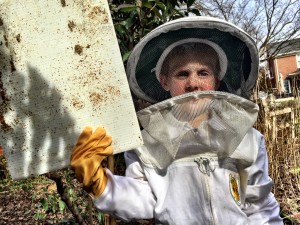Getting Ready – Our New Bees Arrive Saturday – April 29
 It’s Time to get Serious
It’s Time to get Serious
After trying to send two emails with this information through my distribution list, and losing both of them entirely without ever being sent, I have decided I best use our blog to communicate. This Saturday I will travel to West Jefferson to retrieve our bees. This means we must have everything ready so that they can be placed in their new homes.
Please use this post as a guide to insure success.
We will begin our hands on class and demonstration promptly at 4:00 PM this Saturday. This means you need to arrive at least 30 minutes ahead of time to make final prep on your hives, gear up, and prepare for the lessons. I will demonstrate with a new hive I have already placed in the hive all that you will need to do. Then you will complete the same process with your own hives.
ALL MEMBERS of our Bee Teams are encouraged to attend. Those who have a year of experience will now have an opportunity to be a mentor. You are welcome to bring others to observe and photograph from a safe distance. they may even want to bring a lawn chair.
Hands On Lesson Saturday, April 29 – Bee Insertion Day
- Proper Gear and Tools
- Preparing hive to receive bees
- Adding Hive reducer
- Removing 5 frames from bottom deep
- Lighting and using your smoker
- How to move and insert your bees
- Adding Top Feeder with 1:1 Sugar Water solution (1 gallon)
- Closing up and Securing Hive
- Future checking and Feeding your bees
- Keeping your Hive Area in proper order
- Water Sources for your bees
What to do BEFORE Saturday
- Get your tools in order. Decide on how you plan to carry your tools. I use a large plastic tote with 4 compartments. Some simply use a bucket. This is your choice. Include the following tools (you will not use all of these overtime, but when you need them….you need them in a hurry)
- red handled hive tools
- hive brush
- small hammer and a few nails
- duct tape
- small strong flashlight
- pliers – needle nose and regular
- entrance reducer (wooden piece with different sized entrances in your tools)
- toothpicks
- smoker
- lighter
- misting bottle filled with 1:1 sugar water
- small amount of wire or paper clips
- a few rubber bands
- Also bring this Saturday…
- Weight (stone or brick to weight down your hive top)
- jacket and hat with veil (already attached)
- bee gloves
- Be sure to wear long pants, socks, shoes or boots.
- Top Hive Feeder (I will have this ready for you to purchase Saturday
- 1 gallon of simple syrup 1:1 (suggest you mix the night before or that morning)
- Camera (this is a once in a lifetime experience my friends)
- Set your hive up in the Apiary BEFORE Saturday
- You can make a hive stand out of many things. The easiest thing to use is 4 cinder blocks
- Make an appointment with G so he can help you properly locate, set, and level your hive
- STUDY before Saturday
- On our Blog lessons 1 and 5
- Backyard Beekeeper 3 – Lighting your Smoker. The rest of this chapter speaks to installing a package of bees. This does not apply to us as we are installing a Nuclear of bees….very different and much better. Blog lesson 5 does a good job of preparing you for this.
- Also see the videos on lighting your smoker preceding this blog on Saturday

 Please note that each beekeeper is responsible for keeping the grass trimmed or pulled around your hive. Also, check water supply, clean, and fill as needed.
Please note that each beekeeper is responsible for keeping the grass trimmed or pulled around your hive. Also, check water supply, clean, and fill as needed.